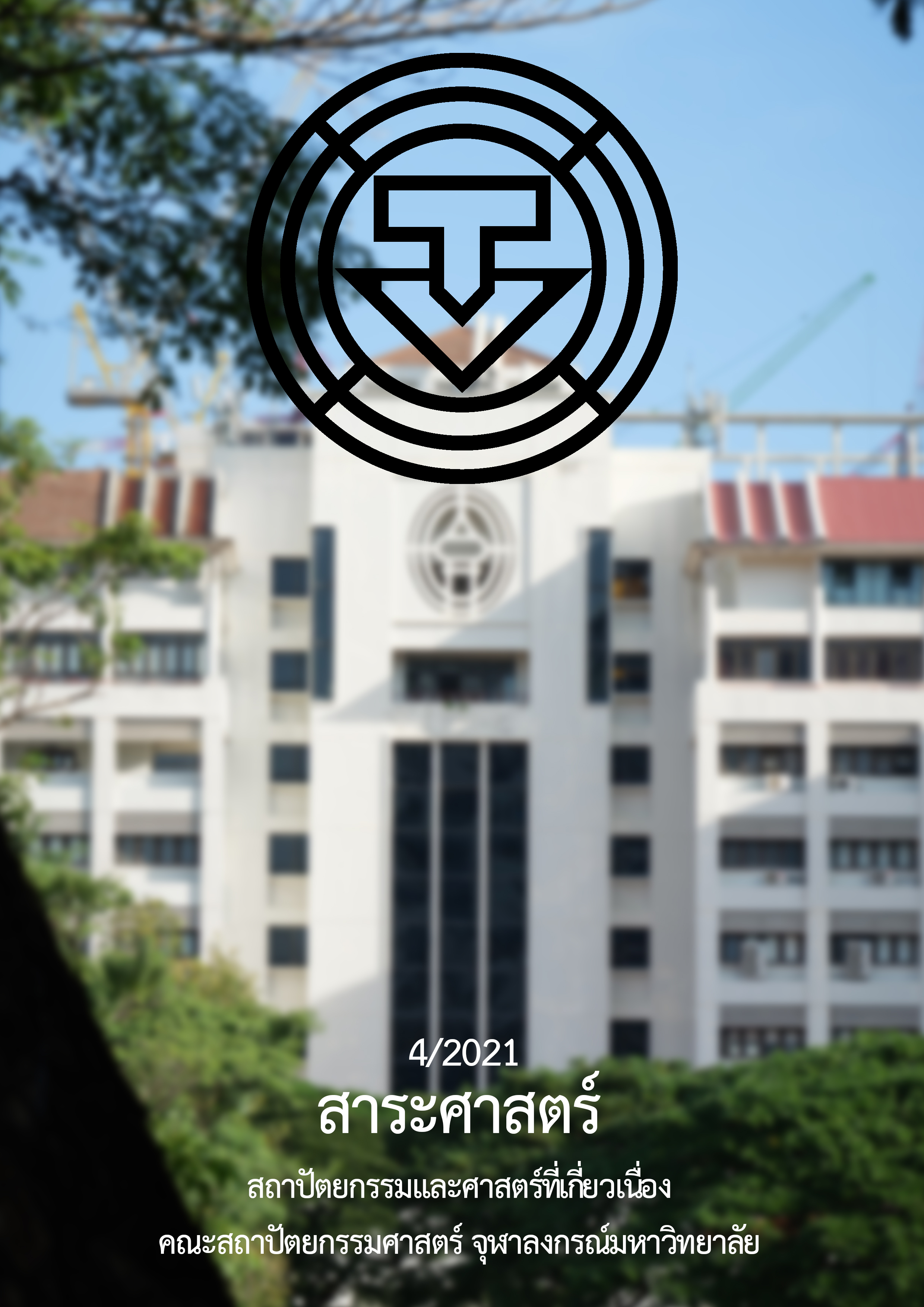Comparison of the Landscape Ecological Conditions between the Ancient and Present Sukhothai City
Main Article Content
Abstract
This study aims to analyse the landscape structures in terms of the fundamental condition in selecting the human’s settlement location and the city capacity; particularly the area of ancient versus present areas of Sukhothai will be thoroughly demonstrated upon the differences of landscape ecological conditions. Geographic information system (GIS) is applied to process landscape structure maps from digital elevation data and geology map, combined with information from related studies. Overlay method is taken into account to illustrate the location of each city and reinterpret effects of ecological conditions on urban settlement.
The results of this study reveal that the settlement choices of the two cities led to different conditions and limitations due to its landscape structure. The ancient Sukhothai city explicitly manifested the understanding of landscape ecology from its choice to situate on the river terrace foothills of Pratak Mountain – as a consequence to survive any flood over 800 years, and make use of adjacent low land area as their agricultural advantages. The old settlement also well adapted furthermore by building landscape infrastructure for water management that solved the area’s problems of flash flood and water deficient during drought season. On the other hand, the present Sukhothai city located by the Yom River, has expanded beyond the natural levee and into the floodplain area, which ended up with risk of flooding every monsoon season; meanwhile the dike-like roads and flood walls that were built, blocked the natural drainage causing even more severe problems to the new city area.
Article Details
References
กรมทรัพยากรธรณี. [ม.ป.ป.]. ข้อมูลภูมิศาสตร์สารสนเทศ กรมทรัพยากรธรณี [shapefile].
กรมแผนที่ทหาร (Cartographer). (2502). แผนที่มาตราส่วน 1 : 50,000 ชุด L708.
กรมแผนที่ทหาร (Cartographer). (2554). แผนที่มาตราส่วน 1 : 50,000 ชุด L7018.
ธิดา สาระยา. (2544). ประวัติศาสตร์สุโขทัย: พลังคน อำนาจผี บารมีพระ. กรุงเทพฯ: เมืองโบราณ.
ธีรศักดิ์ ธนูศิลป์. (2564). พลวัตการจัดการภูมิศาสตร์ – วัฒนธรรมของเมืองโบราณสุโขทัย: มุมมองด้านโบราณคดีและธรณีวิทยา. บรรยายออนไลน์ พิพิธภัณสถานแห่งชาติรามคำแหง.
พระบาทสมเด็จพระมงกุฎเกล้าเจ้าอยู่หัว. (2521). เที่ยวเมืองพระร่วง (พิมพ์ครั้งที่ 10). พระนคร: โรงพิมพ์ บำรุงนุกูลกิจ.(อนุสรณ์ในงานพระราชทานเพลิงศพ พระสุทธิอรรถนฤมนตร์ ณ เมรุหน้าพลับพลาอิศริยาภรณ์ วัดเทพศิรินทราวาส วันที่ 18 มีนาคม พุทธศักราช 2521)
มนตรี ชูวงษ์. (2554). ธรณีสัณฐานวิทยาพื้นฐาน (พิมพ์ครั้งที่ 1). กรุงเทพฯ: เทียนวัฒนาพริ้นท์ติ้ง.
สุจิตต์ วงษ์เทศ (2562). สุโขทัยเมืองพระร่วง วิชาการก้าวหน้าของกรมศิลปากร. ต้นฉบับการประกอบการบรรยาย ให้สำนักพิพิธภัณฑ์ฯ กรมศิลปากร.
สุจิตต์ วงษ์เทศ (บรรณาธิการ). (2531). ข้าวไพร่-ข้าวเจ้า ของชาวสยาม. กรุงเทพฯ: ศิลปวัฒนธรรม.
สำนักงานจังหวัดสุโขทัย. (2541). ประวัติมหาดไทยส่วนภูมิภาคจังหวัดสุโขทัย (พิมพ์ครั้งที่ 2). สุโขทัย: สำนักงานจังหวัดสุโขทัย.
สำนักงานพัฒนาเทคโนโลยีอวกาศและภูมิสารสนเทศ. (2555). ข้อมูลความสูงภูมิประเทศ (เจ้าพระยาโซนนอก) [Digital Elevation Model].
สำนักงานพัฒนาเทคโนโลยีอวกาศและภูมิสารสนเทศ. [ม.ป.ป.]. ข้อมูลน้ำผิวดิน [ข้อมูลสารสนเทศภูมิศาสตร์]. Retrieved from https://flood.gistda.or.th/
เอนก สีหามาตย์. (2560). ระบบชลประทาน และการควบคุมน้ำเมืองเก่าสุโขทัย. นิตยสารศิลปากร, 60(5), 14-27.
Bowen, W. M., & Gleeson, R. E. (2019). The evolution of human settlement. Cham: Palgrave Macmillan.
Bowman, D. (2019). Principle of alluvial fan morphology. Berlin: Springer.
Dheeradilok, P. (1995). Quaternary coastal morphology and deposition in Thailand. Quaternary International, 26,49-54.
Forman, R. T. T. (1995). Land mosaics: The ecology of landscapes and regions. Cambridge, NY: Cambridge University Press.
Forman, R. T. T., & Gordon, M. (1986). Landscape ecology. New York: John Wiley and Sons.
Hamilton, S. (2009). Flood plains. In Gene E. Likens (Ed.), Encyclopedia of inland waters (pp.378-386). Amsterdam: Elsevier.
Junk, W. J., Bayley, P., & Sparks, R. (1989). The flood pulse concept in river-floodplain systems. Paper presented at the International Large River Symposium, Honey Harbour, Ontario, Canada.
Murata, G., & E. Matsumoto. (1974). Natural vegetation and physiography of the central plain of Thailand. Kyoto University Center for Southeast Asian Studies, 12(3), 280-290.
NASA JPL. (2013). NASA shuttle radar topography mission global 1 arc second number [Data set].
NASA EOSDIS Land Processes DAAC. doi:10.5067/MEaSUREs/SRTM/SRTMGL1N.003
Sinsakul, Sin. (2000). Late quaternary geology of the lower central plain, Thailand. Journal of Asian Earth Sciences, 18(4), 415-426.
Opperman, J. J., Moyle, P. B., Larsen, E. W., Florsheim, J. L., & Manfree, A. D. (2017). Floodplains: Processes and management for ecosystem services. Oakland, CA: University of California Press.
Syvitski, J. P. M., Overeem, I. Brakenridge, G. R., & Hannon, M. (2012). Floods, floodplains, delta plains – A satellite imaging approach, Sediment Geology, 1-14. doi: 10.1016/jsedgeo.2012.05.014
Takaya, Y. (1971). Physiography of rice land in the Chao Phraya basin of Thailand. Kyoto University Center for Southeast Asian Studies, 9(3), 375-397.
Thaitakoo, Danai. (2017). Resilient landscape in Southeast Asian cities. Bangkok: Landscape and Urban Ecology Laboratory, Department of Landscape Architecture, Chulalongkorn University.
Zonneveld, I. S. (1989). The land unit – A fundamental concept in landscape ecology, and its application. Landscape Ecology, 3(2), 67-86.
United States Geological Survey. (2017). Landsat level-1 data products [Landsat data]. Retrieved from https://earthexplorer.usgs.gov/


